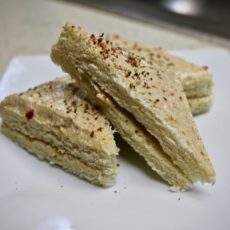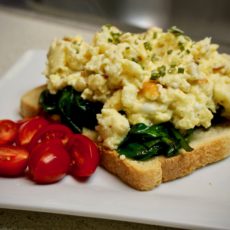Since there’s about to be quite a few salad recipes coming up, I thought I’d put 2-12: Tips About Salad Dressing out there as well. I tried to think of more salad dressing variations than what they list here, but honestly? Most “traditional” salad dressings do fall into one of the three categories they establish: vinaigrette, cream/mayo-based, and low-calorie. Go ahead–can you think of one that doesn’t?
PS: I spy that sneaky tarragon vinegar in their picture below. If you want to learn to make your own, check out 19-7: Fresh and Dried Herbs.

At the restaurant I worked at a few years ago, we made our own dressings from scratch. And by “we”, I mean “me”–I made all the dressings for the whole restaurant every week and kept everything stocked up, since it was my station (garde manger, or pantry chef) that made the salads. We made a blue cheese, ranch, Caesar, creamy balsamic vinaigrette, and another lighter, more traditional vinaigrette.
One of the first times I made the blue cheese dressing (which required a giant immersion blender and a 22-quart Cambro–it’s kind of like mixing concrete in a bucket), a customer liked it so much they asked to buy some to take home. I guess that makes me qualified to write about salad dressings now.
Hey–I have to find something to do while we’re all staying at home for a while. And so do you (probably), so why not read this?

With these types of posts, there’s not really a recipe for me to cook–instead, I usually put together some lists of posts that feature the different categories. That way, you can read/try out related recipes based on the featured ingredient/technique.
This one lays out different types of dressing categories, and as I mentioned in the beginning, they did a pretty good job. Even dressings like Caesar are technically mayo-based (oil + eggs + acid), you’re just making the mayo yourself instead of incorporating the pre-made stuff.

Vinaigrette
Simply Delicious defines this as basically 1 part vinegar to 3-4 parts oil, plus whatever else you’d like to add (herbs, fruit juice, etc.). The biggest difference between this one and the low-calorie section below is the use of vinegar and the amount of oil.
- 2-6: Greek Salad
- 2-11: Santiago Chicken Salad
- 2-14: Quick and Easy Tomato Salad
- 2-17: Spicy Potato Salad (pictured above)
- 2-18: Luncheon Salad
- 2-23: Grilled Chicken Salad
- 2-24: Parisian Ham-Mushroom Salad
- 2-34: Avocado-Parmesan Salad

Mayonnaise/Creamy Dressing
Considering this is America, and our national condiment at this point seems to be Ranch dressing, this is probably the most popular category.
Use your heads, people: it may taste good, but drenching a salad in creamy dressing and then topping it with tons of cheese and meat is NOT going to be great for your long-term health (no matter what you keto people say).
- 1-11: Ham Rolls with Italian Salad
- 2-8: Chicken Salad
- 2-10: Spinach Salad
- 2-13: Waldorf Salad
- 2-20: Potato and Sausage Salad (pictured above)
- 2-36: California Egg Salad

Low Calorie Dressings
Let’s face it–this book is a product of its time (late 1980s-early 1990s). Low-calorie (mostly low fat, NOT low sugar) was all the rage, and the easiest way to do that was to take out (or majorly reduce) the amount of oil/fat in the dressing. If you’re making it yourself, it might not be too bad. But for those of us who remember that era, my biggest salad dressing tip to you is to stay away from anything low-calorie (and specifically advertised as such) that’s sold in the store–it’s going to be disappointing.
- 2-4: Chef’s Salad (pictured above)
- 2-26: Corn and Wild Rice Salad
- 2-37: Chicken-Salami-Rice Salad
- 15-17: Summery Cantaloupe
- 15-19: Layered Fruit Salad



